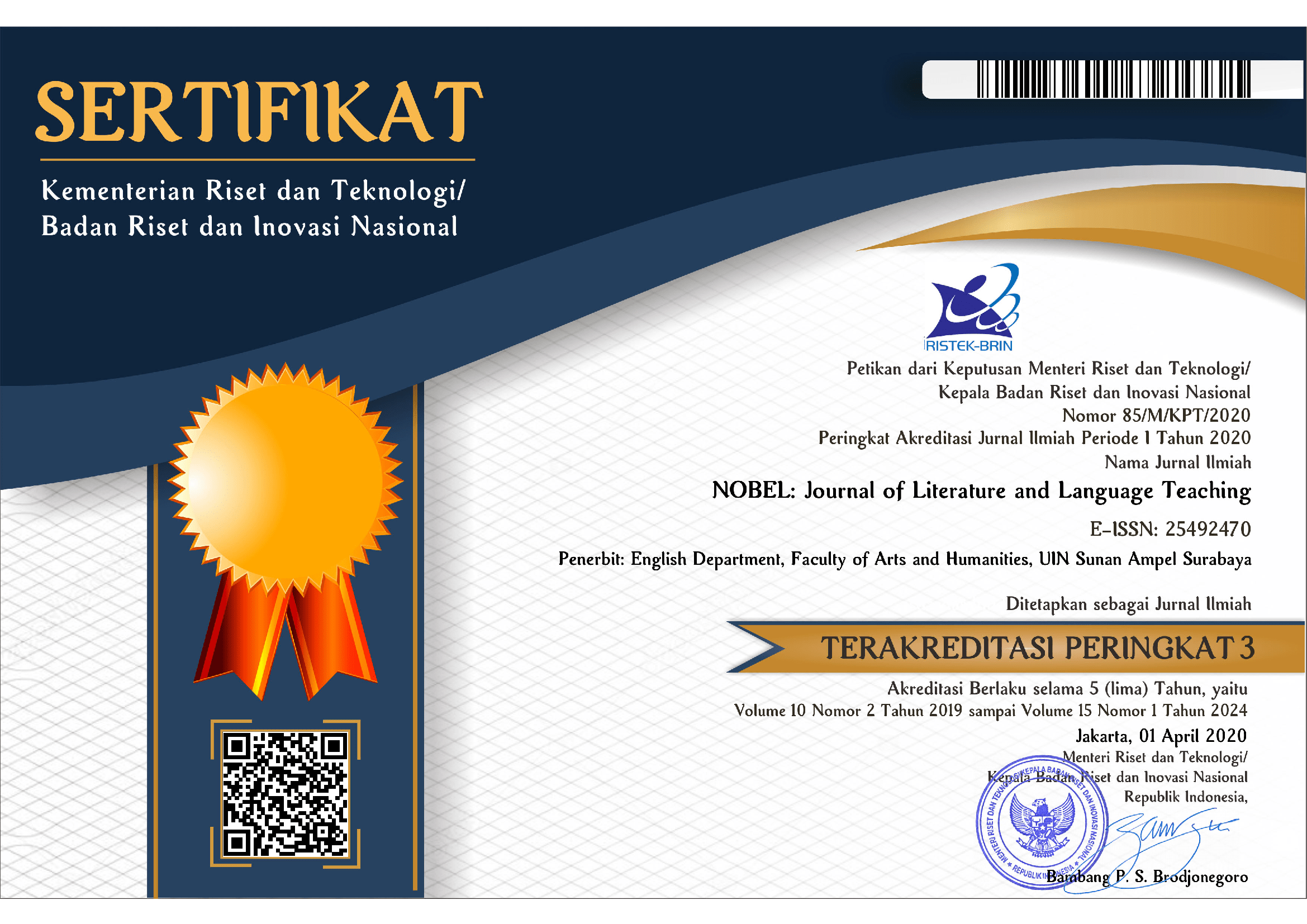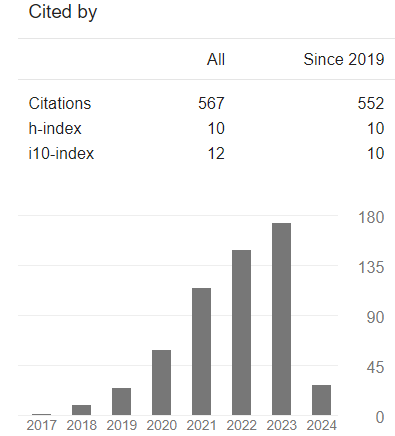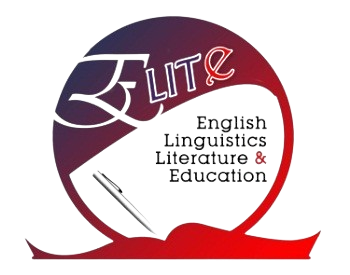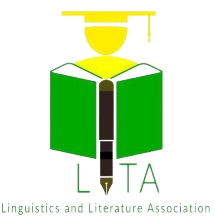Expressive Acts Constructing Religious Identity among Indonesian Muslim Influencers on Instagram
DOI:
https://doi.org/10.15642/NOBEL.2022.13.2.175-192Keywords:
speech act, illocutionary act, expressive act, religious identity, influencerAbstract
The study investigated the expressive act constructing religious identity among Indonesian Muslim influencers on Instagram. Employing a qualitative descriptive method with non-participant observation, the data were obtained by documenting the caption of the posts from the selected influencers' Instagram accounts, taking notes, and selecting the relevant data. The data were analyzed using Searle's (1976) theory and the identity theory by Thornborrow (2004) to examine how the expressive act constructs religious identity. The results showed seven types of expressive speech acts performed by Indonesian Muslim influencers; Fadil Jaidi, Atta Halilintar, Ria Ricis, and Lesty Kejora. Those expressive speech acts are thanking, gratitude, praise, apology, appreciation, condolence, and congratulation. There are 53 data found, and most of the expressive acts uttered by the influencers are thanking others. Furthermore, the group identities are constructed by the representation of Indonesian Muslim influencers by which the language variations were identified from the code-switching they employed. There are also four common manners practiced by the Muslim influencers: 1) show mercy towards everyone, 2) have respect and love for the elder/ younger, 3) keep good relations with everyone, and 4) be kind to parents.
Downloads
References
Al-Rawafi, A. A. A., & Gunawan, W. (2019). The Illocutionary speech acts of Insha'Allah: Pragmatic analysis of teachers talks in daily school activities. Proceedings of the 3rd Asian Education Symposium (AES 2018), 522–528. https://doi.org/10.2991/aes-18.2019.117
Alivin, M. Z. (2021). Identity negotiation in the age of global migration in Exophonic novels. NOBEL: Journal of Literature and Language Teaching, 168–187. https://doi.org/https://doi.org/10.15642/NOBEL.2021.12.2.168-18
Annahlia, K., Edward, E., & Fauzi, M. (2020). Analysing Zakir Naik's illocutionary acts in his speech about Islam's view on terrorism and jihad. Elsya : Journal of English Language Studies, 2(3), 88–92. https://doi.org/10.31849/elsya.v2i3.4942
Aulia, N. Q., Hidayat, D. N., & Alek, A. (2021). Illocutionary acts on Mata Najwa talk show on the theme "Mata Najwa menanti Terawan." Jurnalistrendi: Jurnal Linguistik, Sastra, dan Pendidikan, 6(1), 44–50. https://doi.org/https://doi.org/10.51673/jurnalistrendi.v6i1.483
Austin, J. L. (1962). How to do thing with words. Harvard University Press.
Aziz, J. A., Mahdi, S., & Amalia, R. M. (2017). Directive illocutionary acts by Mario Teguh in "Super Show" talk show: A pragmatics study. The 6th International Conference on Multidisciplinary Research (ICMR) in Conjunction with the International Conference on Electrical Engineering and Informatics (ICELTICs), 605–610. https://jurnal.unsyiah.ac.id/AICS-Social/article/view/10758/8703
Bogdan, B., & Biklen, S. K. (1992). Quality research for education: An introduction to theory and methods. University of California.
Clark, H. (1996). Using language. Cambridge University Press.
Fatmawati, F. (2015). Mikhael's personal identity construction in Paulo Coelho's The Zahir. NOBEL: Journal of Literature and Language Teaching, 6(2), 97–120. https://doi.org/https://doi.org/10.15642/NOBEL.2015.6.2.97-120
Fitriani, F., Masrizal Mahmud, & Nasir, C. (2020). An analysis of illocutionary acts in Fantastic Beasts: The Crimes of Grindelwald movie. Research in English and Education (READ), 5(3), 85–99. http://jim.unsyiah.ac.id/READ/article/view/15855
Ghazanfari, M., Attaran, A., & Zabetipour, M. (2019). Contemporary sociopolitical functions of the "Allahu Akbar" ritual speech act in today's Muslim communities: A focus on the Iranian society. International Journal of Society, 7(2), 94–106. http://www.ijscl.net/article_36683_b09db534965e9ebea597d67796f1d2be.pdf
Hidayah, R., & Milal, D. (2016). Ideal identity construction in beauty product advertisement of Garnier. NOBEL: Journal of Literature and Language Teaching, 7(2), 120–136. https://doi.org/10.15642/NOBEL.2016.7.2.120-136
Indriani, I., & Emmiyati, N. (2015). Illocutionary acts in "Midnight in Paris" movie. ELITE: English and Literature Journal, 2(1), 92–107. https://journal.uin-alauddin.ac.id/index.php/elite/article/view/3385
Kaplan, R. . (2000). Why is English a global language? Problems and perplexities. In H. W. Kam & C. Ward (Eds.), Language in the Global Context (pp. 268–283). SEAMEO RELC.
Lawrence, C. B. (2012). The Korean English linguistic landscape. World Englishes, 31(1), 70–92. https://doi.org/10.1111/j.1467-971X.2011.01741.x
Leech, G. (1983). Principles of Pragmatics. Longman Linguistics Library.
Levitt, H. M., Bamberg, M., Creswell, J. W., Frost, D. M., Josselson, R., & Suárez-Orozco, C. (2018). Journal article reporting standards for qualitative primary, qualitative meta-analytic, and mixed methods research in psychology: The APA Publications and Communications Board task force report. American Psychologist, 73(1), 26–46. https://doi.org/10.1037/amp0000151
Marcus, B. P. (2017). Religious identity formation. Religious Freedom Center of the Freedom Forum Institute. https://www.religiousfreedomcenter.org/grounding/identity/
Mauranen, A. (2003). The corpus of English as lingua franca in academic settings. TESOL Quarterly, 37(3), 513-527. https://doi.org/10.2307/3588402
Milal, A. D., & Kusumajanti, W. (2020). Assertive speech acts performed by teacher in EFL classes. NOBEL: Journal of Literature and Language Teaching, 11(1), 83–100. https://doi.org/10.15642/NOBEL.2020.11.1.83-100
Miles, M. B., Huberman, A. M., & Saldana, J. (2016). Qualitative data analysis: A methods sourcebook. SAGE Publications Inc.
Norrick, N. R. (1978). Expressive illocutionary acts. Journal of Pragmatics, 2(3), 277–291. https://doi.org/10.1016/0378-2166(78)90005-X
Norton, B., & Toohey, K. (2011). Identity, language learning, and social change. Language Teaching, 44(4), 412–446. https://doi.org/10.1017/S0261444811000309
Nugroho, M., Tarjana, S. S., & Purnanto, D. (2018). The speech acts of suggestion by Islamic preachers (Da'i) in dialogic da'wah in the city of Surakarta. Proceedings of the Fourth Prasasti International Seminar on Linguistics (Prasasti 2018), 401–405. https://doi.org/10.2991/prasasti-18.2018.73
Nuswantara, K., Rohmah, Z., & Kusumawardani, R. P. (2019). Corpus-based analysis of cohesive devices in academic essays written by Indonesian students: Across-gender analysis. Pertanika Journal of Social Science and Humanities, 27(4), 2265–2284. http://www.pertanika.upm.edu.my/pjssh/browse/regular-issue?article=JSSH-4075-2018
Renaldo, Z. A. (2021). Emotions and illocutionary acts used by polytechnic students in describing online learning issue. ELT-Lectura, 8(1), 15–23. https://doi.org/10.31849/elt-lectura.v8i1.5977
Rohmah, Z. (2005). English as a global language: Its historical past and its future. Bahasa Dan Seni, 33(1), 106–117. https://sastra.um.ac.id/wp-content/uploads/2009/10/English-as-a-Global-Language-Its-Historical-Past-and-Its-Future-Zuliati-Rohmah.pdf
Ronan, P. (2015). Categorizing expressive speech acts in the pragmatically annotated SPICE Ireland corpus. ICAME Journal, 39(1), 25–45. https://doi.org/10.1515/icame-2015-0002
Searle, J. R. (1979). Expression and meaning. Cambridge University Press.
Silitonga, A. J. (2018). An analysis of illocutionary acts as found in Jane Austen's Manfield Park. Jurnal LITTERA, 1(2), 28–46. http://jurnal.darmaagung.ac.id/index.php/littera/article/view/61
Silva, A. M. da. (2017). Exploring the language choice of the non-commercial signs in Jakarta. Indonesian Journal of Applied Linguistics, 7(2), 467-475. https://doi.org/10.17509/ijal.v7i2.8355
Suhandoko, S., Lyatin, U., & Ningrum, D. R. (2021). Impoliteness and gender differences in the Edge of Seventeen movie. NOBEL: Journal of Literature and Language Teaching, 12(2), 228–242. https://doi.org/10.15642/NOBEL.2021.12.2.228-242
Sukinah, S., & Effendi, A. (2021). Teacher’s illocutionary acts in online learning interactions. Jurnal Pendidikan Dan Pengajaran, 54(1), 28–37. https://doi.org/https://doi.org/10.23887/jpp.v54i1
Tambunan, S. D. (2020). The illocutionary acts and the translation techniques in Sherlock Holmes movie series. Journal of Language and Literature, 8(2), 182–195. https://doi.org/10.35760/jll.2020.v8i2.3236
Thornborrow, J. (2004). Language and identity. In L. Thomas & S. Wareing (Eds.), Language, society and power: An introduction (pp. 135–150). Routledge.
Wahyudiantari, N. W. P., Budiarsa, M., Yadnya, I. B. P., & Satyawati, M. S. (2020). illocutionary acts of the characters in wonder: A novel by R.J. Palacio. International Journal of Linguistics, Literature and Culture, 6(3), 36–40. https://doi.org/10.21744/ijllc.v6n3.949
Wardoyo, C., Marlina, L., Darmalakasana, W., Suntana, I., & Kahmad, D. (2018). Theolinguistic study of directive speech acts performed by Islamic preacher in Friday sermon in Bandung Indonesia. Proceedings of the 2nd International Conference on Sociology Education (ICSE), 178–183. https://core.ac.uk/download/pdf/327164875.pdf
Weatherall, A. (2002). Gender, language and discourse. Routledge.
Yoniartini, D. M. (2021). Lanskap linguistik kawasan pusat pendidikan di kota Mataram. Jurnal Ilmiah Telaah, 6(2), 162–168. https://doi.org/10.31764/telaah.v6i2.6189
Yule, G. (1996). Pragmatics. Oxford University Press.
Yusuf, K., Mukhrozah, P. A., Jannah, R., Jauharoh, T., & Putra, F. A. (2022). Language patterns in the linguistic landscape of pesantren. Jurnal Al-Lughah, 11(1), 28–44. https://doi.org/10.29300/lughah.v11i1.6419
Downloads
Published
How to Cite
Issue
Section
License
Copyright (c) 2022 NOBEL: Journal of Literature and Language Teaching

This work is licensed under a Creative Commons Attribution 4.0 International License.







